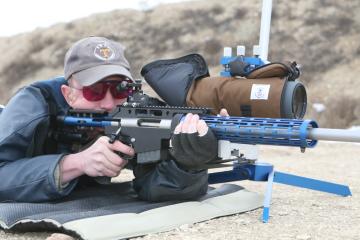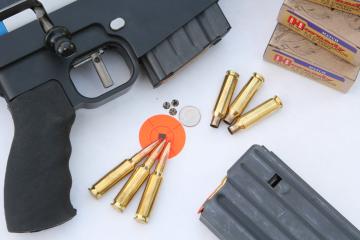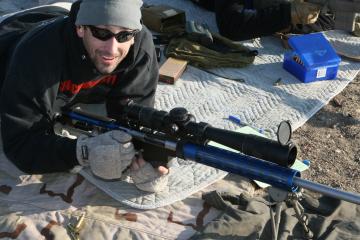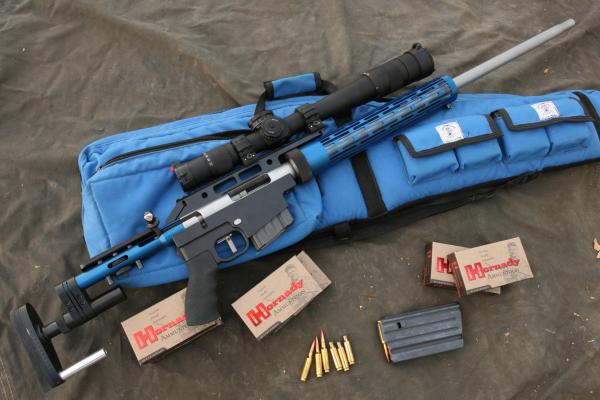6.5 Creedmoor
The 6.5 Creedmoor was developed for the express purpose to provide a cartridge with the accuracy and
ballistics to be competitive at the top level of High-Power Long-Range competition using factory
ammunition, while also being easy on the novice reloader. During the 2006 High-Power Championships
at Camp Perry, Hornady's Chief Ballistician Dave Emary was chatting with Service Rifle and National
High Power Champion Dennis DeMille. Dave asked Dennis what his ideal competitive round would look
like. His answer was that it would shoot high-BC bullets with great accuracy for winning long-range
performance; it would have low recoil and have comparatively long barrel life; factory long-range

Emary and the Hornady engineers went to work and by early 2007 had come up with a cartridge roughly based on the .308 body size, shooting a 6.5 mm bullet. The case has a 30-degree shoulder and a 0.370-inch neck. The case head is identical to .308 Winchester which makes it a shoe-in to any .308 action, and the body is tapered 0.004-inch per side for extraction reliability. While reloaders will indubitably try to hotrod the cartridge, factory ammunition is limited to 58,000 psi and shoots the 140-gr A-MAX (BC 0.585) at 2810 fps from a 26-inch barrel. Compared to some long-range ammunition which runs at a maximum pressure over 60,000 psi, being able to achieve a respectable 2800 fps with the high-BC 6.5 mm bullets will increase safety, aid reliability, and provide long brass life. For reduced recoil or short-course matches, the factory 120-gr A-MAX (BC 0.465) loads run at 2980 fps. The Gun
At this point the consistent experimental method suffers a blow. Up until now, all testing was
done on the same rifle platform: the AI-AW. For the 6.5 Creedmoor, I was only able to get a barrel
for its native competition rifle, the Tubb 2000, from McMillan. I borrowed a Tubb rifle from
fellow practical shooter Tom Freeman for the test. Since I'm not an aperture or metallic sight
shooter, US Optics provided a 3.8-22x44 mm SN-3 with a mil-scale reticle and EREK 0.1-mil elevation
knob for the project. The barrel finished at 28 inches and was not threaded for a muzzle device.
Bottom-line: Load, Ballistics, Accuracy
140-gr Factory Load: 140gr A-Max @ 2770 fps, 41.7gr H4350, 210M, Hornady Brass.120-gr Factory Load: 120gr A-Max @ 2980 fps, 43.5gr H4350, 210M, Hornady Brass. From a 100-yard zero, the 140-gr load needs 7.7 mils of elevation to 1000 yards, and will drift 59 inches with a 10 mph cross. Accuracy was 1/2 MOA or a little better. 6.5 Creedmoor, 140 AMAX @ 2810 Zero 100yd 5000' Density Altitude RANGE ELEV- moa mil | WIND(10) moa mil RANGE 100 0" 0.00 0.0mil | 0" 0.50 0.1mil 100 200 3" 1.25 0.4mil | 2" 1.00 0.3mil 200 300 11" 3.50 1.0mil | 4" 1.25 0.4mil 300 400 25" 6.00 1.8mil | 8" 1.75 0.5mil 400 500 46" 8.75 2.5mil | 13" 2.50 0.7mil 500 600 74" 11.75 3.4mil | 18" 3.00 0.8mil 600 700 110" 15.00 4.3mil | 26" 3.50 1.0mil 700 800 155" 18.50 5.4mil | 35" 4.25 1.2mil 800 900 210" 22.25 6.5mil | 45" 4.75 1.4mil 900 1000 276" 26.25 7.7mil | 57" 5.50 1.6mil 1000 
Load Development Notes
Due to limited time and a limited amount of pre-production 6.5 Creedmoor brass from Hornady, my load
testing wasn't comprehensive. I think long-range shooters will be pleased with the results with the
120 and 140-grain A-MAX bullets; however, I couldn't resist trying some other 6.5 mm bullets in the
Creedmoor case. Sticking with Federal 210M primers and H4350, I loaded and shot the 139-grain Lapua
Scenar and the 130-grain Berger VLD. Both bullets shot excellent groups like the factory
ammunition. The Scenars shot at just about the same velocity as the 140-grain A-MAX when loaded
with the same charge. The 130-gr Berger VLD split the velocity of the two factory loads at about
2900 fps. For the reloader willing to push pressure a little bit, I think this cartridge has some
headroom.
Ammo and Components
Hornady intends the 6.5 Creedmoor to be an off-the-shelf solution for long-range shooters, and
offers several long-range factory loads for that purpose. The 140-gr load is specced at 2810 fps
and the 120-gr load is specced at 2980 fps from a 26-inch barrel. The reloading recipe for each
load is printed on every box of factory ammunition, so replicating or improving on the factory loads
won't be a mystery.
Although no production brass was available at the time of this review, the pre-production brass was good quality. Judging based on the quality of Hornady's other brass, I expect the production brass to be good quality and affordable, at probable under $0.60/pc. 
Pros
Cons
Match Performance
I haven't yet had an opportunity to run the 6.5 Creedmoor in practical/field matches. Based on its
accuracy and ballistic performance, I expect it to provide exactly the same results as .260
Remington. Dennis DeMille shot the 6.5 Creedmoor during the 2007 NRA High-Power Long-Range season
and had great success. It is reported that as soon as he switched to the 6.5, his rapid fire groups
and scores went through the roof, and he set a new personal best at the 600 yard line with 200/15X.
Summary
Hornady has the right mind-set to make its new cartridge a success in the competitive and practical
market, unlike Remington who basically let the .260 languish in a few hunting rifles.
|
